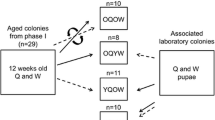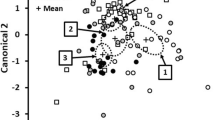Abstract
Temporal change in colonial labor allocation, age structure, eclosion of workers, and numbers of eggs, larvae, and pupae in colonies of the ponerine ant,Diacamma sp., from Japan was surveyed for more than a year. Fluctuation of brood indicated that temporal variation in eclosion is caused by brood raising, not by cessation of egg supply. Labor allocation patterns at a given moment were related to subsequent colonial productivity by multiple linear regression. Fluctuating eclosion patterns can be predicted from labor allocation patterns extrapolated from their age structure, without considering behavioral flexibility. The predictions agree with observed patterns. This suggests that behavioral flexibility does not fully compensate for the deterioration in productivity caused by the fluctuation in age structure.
Similar content being viewed by others
References
Altmann, J. (1974). Observational study of behaviours: samplig methods.Behaviour 49: 227–267.
Brian, M. V. (1956). Group form and the cause of working inefficiency in the antMyrmica rubra L.Physiol. Zool. 29: 173–194.
Calabi, P., and Nonacs, P. (1994). Changing colony growth rates inCamponotus floridanus as a behavioural response to conspecific presence (Hymenoptera: Formicidae).J. Insect Behav. 7: 17–27.
Calabi, P., and Traniello, J. F. A. (1989). Behavioural flexibility in age castes of the antPheidole dentata.J. Insect Behav. 2: 663–677.
Cole, B. J. (1986). The social behaviour ofLeptothorax allardycei (Hymenoptera, Formicidae): Time budgets and the evolution of worker reproduction.Behav. Ecol. Socibiol. 18: 165–173.
Cole, B. J. (1991). Short-term activity cycles in ants: A phase-response curve and phase resetting in worker activity.J. Insect Behav. 4: 129–137.
Cole, B. J. (1991). Short-term activity cycles in ants: Generation of periodicity by worker interaction.Am. Nat. 137: 244–259.
Cole, B. J. (1992). Short-term activity cycles in ants: Age-related changes in tempo and colony synchrony.Behav. Ecol. Sociobiol. 31: 181–187.
Fukumoto, Y., and Abe, T. (1983). Social organization of colony movement in the tropical ponerine ant,Diacamma rugosum (Le Guillou).J. Ethol. 1: 101–108.
Fukumoto, Y., Abe, T., and Taki, A. (1989). A novel form of colony organization in the “queenless” antDiacamma rugosum.Physiol. Ecol. Japan 26: 55–61.
Gordon, D. M. (1987). Group-level dynamics in harvester ants: Young colonies and the role of patrolling.Anim. Behav. 35: 833–843.
Gordon, D. M. (1991). Variation and change in behavioural ecology.Ecology 72: 1196–1203.
Lenoir, A. (1979). Feeding behaviour in young societies of the antTapinoma erraticum L.: Trophallaxis and polyethism.Insectes Soc. 26: 19–37.
Lenoir, A. (1987). Factors determining polyethism in social insects. In Pasteels, J. M., and Deneubourg, J.-L. (eds.),From Individual to Collective Behaviour in Social Insects, Birkhäuser Verlag, Basel, pp. 219–240.
Nakata, K. (1995). Age polyethism, idiosyncrasy and behavioural flexibility in the queenless ponerine ant,Diacamma sp.J. Ethol. 13: 113–123.
Oster, G. F., and Wilson, E. O. (1978).Caste and Ecology in the Social Insects, Princeton University Press, Princeton, NJ.
Peeters, C., and Billen, J. P. J. (1991). A novel exocrine gland inside the thoracic appendages (“gemmae”) of the queenless antDiacamma australe.Experientia 47: 229–231.
Peeters, C., and Tsuji, K. (1993). Reproductive conflict among ant workers inDiacamma sp. from Japan: Dominance and egg cannibalism in the absence of the gamergate.Insectes Soc. 40: 119–136.
Robinson, G. E., Page, R. E., Strambi, C., and Strambi A. (1992). Colony integration in honey bees: Mechanisms of behavioural reversion.Ethology 90: 336–348.
Seeley, T. D. (1982). Adaptive significance of the age polyethism schedule in honeybee colonies.Behav. Ecol. Sociobiol. 11: 287–293.
Tsuji, K. (1994). Inter-colonial selection for the maintenance of cooperative breeding in the antPristomyrmex pungens: A laboratory experiment.Behav. Ecol. Sociobiol. 35: 109–113.
Wheeler, W. M., and Chapman, J. W. (1992). The mating ofDiacamma.Psyche 29: 209–211.
Wilson, E. O. (1971).The Insect Societies, Belknap Press of Harvard University Press, Cambridge, MA.
Wilson, E. O. (1976). Behavioural discretization and the number of castes in an ant species.Behav. Ecol. Sociobiol. 1: 141–154.
Wilson, E. O., and Hölldobler, B. (1988). Dense heterarchies and mass communication as the basis of organization in ant colonies.TREE 3: 65–68.
Author information
Authors and Affiliations
Rights and permissions
About this article
Cite this article
Nakata, K. Does behavioral flexibility compensate or constrain colony productivity? Relationship among age structure, labor allocation, and production of workers in ant colonies. J Insect Behav 9, 557–569 (1996). https://doi.org/10.1007/BF02213880
Revised:
Issue Date:
DOI: https://doi.org/10.1007/BF02213880




